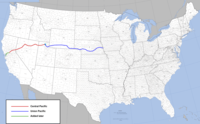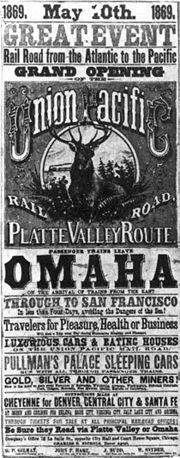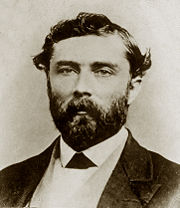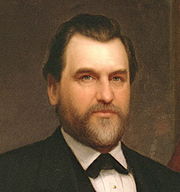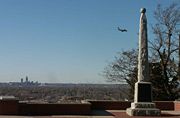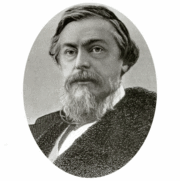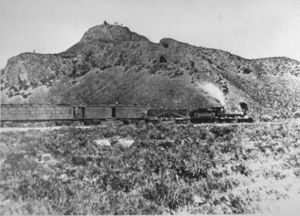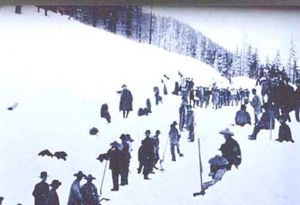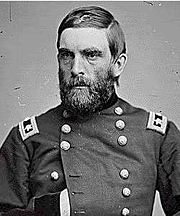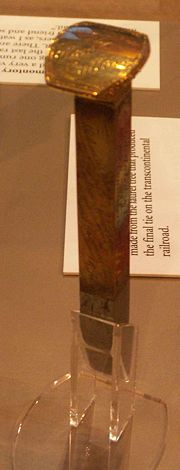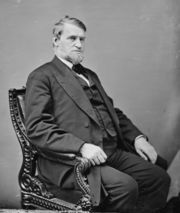First Transcontinental Railroad
2008/9 Schools Wikipedia Selection. Related subjects: Railway transport
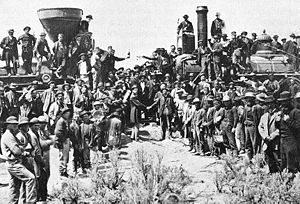
The "First Transcontinental Railroad" is the name of a railroad line across the United States linking Omaha, Nebraska with Sacramento, California in the 1860s, linking the railway network of the Eastern United States with California on the Pacific coast. Ceremonially completed on May 10, 1869, at the famous " golden spike" event at Promontory Summit, Utah, it created a nation-wide mechanized transportation network that revolutionized the population and economy of the American West. This network caused the wagon trains of previous decades to become obsolete, exchanging it for a modern transportation system.
Authorized by the Pacific Railway Act of 1862 and heavily backed by the federal government, it was the culmination of a decades-long movement to build such a line and was one of the crowning achievements of the presidency of Abraham Lincoln, completed four years after his death. The building of the railway required enormous feats of engineering and labor in the crossing of plains and high mountains by the Union Pacific Railroad and Central Pacific Railroad, the two privately chartered federally backed enterprises that built the line westward and eastward respectively.
The building of the railroad was motivated in part to bind the Union together during the strife of the American Civil War. It substantially accelerated the populating of the West by white homesteaders, while contributing to the decline of the Native Americans in these regions. In 1879, the Supreme Court of the United States formally established, in its decision regarding Union Pacific Railroad vs. United States (99 U.S. 402), the official "date of completion" of the Transcontinental Railroad as November 6, 1869.
The Central Pacific and the Southern Pacific Railroad combined operations in 1870 and formally merged in 1885. Union Pacific originally bought the Southern Pacific in 1901 but in 1913 was forced to divest it; the company once again acquired the Southern Pacific in 1996. Much of the original right-of-way is still in use today and owned by the Union Pacific.
The railroad was considered the greatest American technological feat of the 19th century. It served as a vital link for trade, commerce and travel that joined the eastern and western halves of late 19th century United States. The transcontinental railroad quickly ended the romantic yet far slower and more hazardous stagecoach lines that had preceded it. The subsequent march of "Manifest Destiny" and proliferation of the so-called "Iron Horse" across Native American land greatly accelerated the demise of Great Plains Indian culture.
Route
The route followed the main trails used for the opening of the West pioneered by the Oregon, Mormon, California Trails and the Pony Express. Going from Council Bluffs, Iowa, it followed the Platte River through Nebraska, left the traditional route to cross the Rocky Mountains at the Great Divide Basin in Wyoming and then cut down through northern Utah and Nevada in the Great Basin before crossing the Sierras to Sacramento.
The route did not pass through the two biggest cities in the Great American Desert -- Denver, Colorado and Salt Lake City, Utah. Feeder lines were built to service the two cities.
When it started, it was not directly connected to the Eastern U.S. rail network. Instead, trains had to be ferried across the Missouri River. In 1872, the Union Pacific Missouri River Bridge opened and directly connected the East and West.
The Central Pacific laid 690 miles (1,110 km) of track, starting in Sacramento, California, and continuing through California ( Newcastle and Truckee), Nevada ( Reno, Wadsworth, Winnemucca, Battle Mountain, Elko, Humboldt-Wells), and connecting with the Union Pacific line at Promontory Summit in the Utah Territory. Later, the route was extended to the Alameda Terminal in Alameda, California, and shortly thereafter, to the Oakland Long Wharf at Oakland Point in Oakland, California.
The Union Pacific laid 1,087 miles (1,749 km) of track, starting in Council Bluffs, and continuing across the Missouri River and through Nebraska ( Elkhorn, now Omaha, Grand Island, North Platte, Ogallala, Sidney, Nebraska), the Colorado Territory ( Julesburg), the Wyoming Territory ( Cheyenne, Laramie, Green River, Evanston), the Utah Territory ( Ogden, Brigham City, Corinne), and connecting with the Central Pacific at Promontory Summit.
Modern-day Interstate 80 closely follows the path of the railroad, with one exception. Between Echo, Utah and Wells, Nevada, Interstate 80 passes through the larger Salt Lake City and passes along the south shore of the Great Salt Lake. The Railroad instead followed the Weber River to Ogden (a route now used for Interstate 84) and around the north side of the Great Salt Lake. While routing the railroad along the Weber River, workers planted the thousand-mile tree, where a marker still stands, to commemorate the milestone.
History
California Developments
Asa Whitney
Talk of a transcontinental railroad to be the centerpiece of the United States manifest destiny started in 1830, shortly after railroads began large scale operation in the United States and English-speaking settlers began settling in Mexican controlled California. Much of the early debates was not so much over whether it would be built, but what route it should follow: a "central" route, avoiding the worst of the Rocky Mountains via the Platte River in Nebraska and the South Pass in Wyoming, or a southern route, avoiding the Rockies by going through Texas to Los Angeles. (A "northern" route which Lewis and Clark followed along the Missouri River would have gone through northern Montana to Oregon and was considered impractical because of snow.)
The most prominent champion of the central route railroad at this time was Asa Whitney (a distant cousin to cotton gin inventor Eli Whitney). Whitney envisioned a route from Chicago and the Great Lakes to northern California, paid for by the sale of land to settlers along the route.
In June 1845 Whitney led a team along the route to assess its capabilities. Whitney travelled widely to solicit support from businessmen and politicians, printed maps and pamphlets, and submitted several proposals to Congress, all at his own expense. Legislation to begin construction of the Pacific Railroad (called the Memorial of Asa Whitney) was first introduced to Congress by Representative Zadock Pratt.
Congress did not act on Whitney's proposal. California came under formal United States control in 1848 with the Treaty of Guadalupe Hidalgo at the conclusion of the Mexican-American War. Settlement of California skyrocketed with California Gold Rush of 1849.
Whitney was to see the central route completed although he was not formally involved.
The southern route and the Gadsden Purchase
Concerns lingered that snow would make the central route to California impractical. A survey indicated that the best path for a southern route ran through the northernmost part of Mexico. Therefore in 1853 the United States made the Gadsden Purchase, acquiring the southern portions of what is now New Mexico and Arizona, so the southern route would be entirely within the U.S. However, Congress did not then agree to support construction on the southern route (or any route), as the decision became embroiled in the sectional dispute that turned into the American Civil War.
Theodore Judah
The next big champion of the central route was Theodore Judah.
Judah was chief engineer for the newly formed Sacramento Valley Railroad in 1852. Although the railroad was to go bankrupt he was convinced that a properly financed railroad could pass from Sacramento through the Sierra Nevada mountains to reach the Great Basin and hook up with rail lines coming from the East.
In 1856 he wrote a 13,000-word proposal in support of a Pacific railroad and distributed it to Cabinet secretaries, congressmen, and other influential people.
In September 1859, Judah was chosen to be the accredited lobbyist for the Pacific Railroad Convention. The convention approved his plan to survey, finance, and engineer the road. Judah returned to Washington in December 1859, where he was given an office in the United States Capitol, an audience with President James Buchanan, and he represented the Convention before Congress.
In February 1860 Iowa Representative Samuel Curtis introduced a bill to build the railroad. It passed the House but died when it could not be reconciled with the Senate version.
Judah returned to California in 1860. He continued to search for a more practical pass through the Sierras suitable for a railroad. In the summer of 1860, a local miner, Daniel Strong, had surveyed a route over the Sierras for a wagon road, a route he realized would also suit a railroad. He described his discovery in a letter to Judah, and together they formed an association to solicit subscriptions from local merchants and businessmen to support their paper railroad.
From January or February 1861 until July, the party of ten led by Judah and Strong surveyed the route for the railroad over the Sierra Nevada, through Clipper Gap, Emigrant Gap, Donner Pass, and south to Truckee.
Judah was to die before major construction began after contracting Yellow Fever while returning over the Isthmus of Panama from New York where he was attempting to get financing to buy out The Big Four.
The Big Four and Central Pacific Railroad
Collis Huntington, a hardware merchant, heard Theodore Judah lecture at the St. Charles Hotel in Sacramento in November 1860, and he invited Judah to his office to hear his proposal in detail. Huntington was to change the Judah's strategy of finding several investors and instead sought to raise the money from three partners who initially invested $1,500 each and form a board of directors: Mark Hopkins, his business partner; James Bailey, a jeweller; Leland Stanford, a grocer and the future governor of California; and Charles Crocker, a dry-goods merchant. The investors became known as the The Big Four and their railroad was called the Central Pacific Railroad.
Pacific Railroad Act
The Pony Express from 1860 to 1861 was to prove that the central route was viable during the winter. With the American Civil War raging and a secessionist movement in California gaining steam, the need for the railroad became more urgent.
In 1861 Curtis again introduced a bill establish the railroad, but it did not pass. The House of Representatives on May 6, 1862, and the Senate on June 20 finally approved it. Lincoln signed it into law on July 1. The act established the two main lines -- the Central Pacific from the west and the Union Pacific from the east. Other rail lines could build feeder lines.
Each was required to build only 50 miles (80 km) in the first year; after that, only 50 miles (80 km) more were required each year. Besides land grants along the right-of-way, each railroad was subsidized $16,000 per mile ($9,940/km) built over an easy grade, $32,000 per mile ($19,880/km) in the high plains, and $48,000 per mile ($29,830/km) in the mountains. The race was on to see which railroad company could build the longest section of track.
Eastern Developments
Eastern Terminus
Once it was decided that the railroad would follow the central route rather than the southern route, there was little question that the western terminus would be Sacramento. However, there was considerable intrigue over the eastern terminus.
The three prime candidates for the eastern terminus on 250 miles (400 km) of Missouri River between Kansas City and Omaha were:
- Council Bluffs/Omaha proposed by Thomas Durant via an extension of his proposed Mississippi and Missouri Railroad via the new Union Pacific Railroad.
- St. Joseph, Missouri via the Hannibal and St. Joseph Railroad (H&SJ).
- Kansas City, Kansas/ Leavenworth, Kansas via the Leavenworth, Pawnee and Western Railroad (LP&W) (later called the Kansas Pacific) controlled initially by Thomas Ewing, Jr. and later by John C. Fremont.
The principal advantages of Council Bluffs/Omaha was that it was well north of the Civil War fighting taking place in Missouri, was the shortest route to South Pass break in the Rockies in Wyoming, and would follow a fertile river that would encourage settlement. Missouri's advantages included that it had the only railroad to actually reach the Missouri River on its western border (H&SJ), was more centrally located for lines coming up from Texas and could offer a route servicing Denver, Colorado, the biggest city in the Great American Desert. In 1862 the closest rail lines to Omaha/Council Bluffs were 150 miles (240 km) away and would take five years to reach Omaha.
Thomas Durant who was building the cross-Iowa railroad (the M&M) was literally banking that the Omaha route would be chosen and began buying up land in Nebraska.
In 1857, Durant hired private citizen Abraham Lincoln to represent the M&M in litigation brought by steamboat operators to dismantle Government Bridge, the first bridge across the Mississippi River. In August 1859 Lincoln at the behest of M&M attorney Norman Judd travelled to Council Bluffs to inspect M&M facilities and that were to be used to secure a $3,000 loan Lincoln was to hold. On the visit Lincoln rode the SJ&H railroad and visited railroad locations in Missouri and Kansas before going to Council Bluffs. During the visit Lincoln was to spend 2 hours with M&M engineer Grenville M. Dodge at the Pacific House Hotel discussing the merits of starting the railroad in Council Bluffs and was to visit Cemetery Hill there to look over the proposed route.
Lincoln's ties to Council Bluffs were furthered strengthened by the fact that he had won the 1860 Republican nomination on the third ballot when the Iowa delegation switched its vote to him. In contrast, Lincoln was to get only 10 percent of the Missouri vote in the 1860 Presidential Election.
While the Pacific Railroad Act was to award the eastern contract to the newly formed Union Pacific, it was left up to then President Lincoln to formally choose the location for the railroad to start and Lincoln in 1862 was to follow the advice of his former client.
The H&SJ and LP&W were not totally shut out of the contract though. The H&SJ was to be allowed to build a feeder line from Atchison, Kansas while the LP&W could build a feeder line out of Kansas City, Kansas. The feeder lines were supposed to meet the Union Pacific main line somewhere around the 100th meridian in central Nebraska and the feeder lines were to get the same land grant incentives as the Union Pacific.
Thomas Durant and the Union Pacific
In contrast to the relatively straight forward arrangements for the Central Pacific, the Union Pacific which was to ultimately build nearly 2/3 of the track was to be mired in controversy and scandals while its controlling partner Thomas C. Durant got rich as he took advantage of lax or non-existent government oversight during the Civil War.
The enabling legislation for the Union Pacific required that no partner was to own more than 10 percent of the stock. However, the Union Pacific had problems selling its stock. Durant enticed investors with a scheme where he would put up the money for the stock if they would just put their names on it. Then Durant wound up taking the stock from the investors and was to end up controlling about half the stock of the railroad.
The initial construction of railroad went over land that Durant owned around Omaha. Being paid by the mile, the railroad built oxbows of extraneous track never venturing further than 40 miles (64 km) from Omaha in the railroad's first 2 1/2 years.
Durant manipulated market prices on his stocks by spreading rumours about which railroads were to be connected to the Union Pacific. First he ran up the stock of his M&M Railroad while secretly buying stock in the depressed Cedar Rapids and Missouri Railroad (CR&M), then running up CR&M stock with new plans to connect the Union Pacific to it at which point he began buying back the M&M stock at depressed prices. The gambit is estimated to have raised $5 million for his cohorts and him.
Durant was to keep a low public profile in his mechanizations as he was only a vice president. He was to install a series of respected men such as John Adams Dix as president of the railroad.
On July 4, 1865, the Union Pacific had not gone further than 40 miles (64 km) from Omaha -- even as the Central Pacific had been working away for 2 1/2 years. With the end of the Civil War and increased government supervision in the offing, Durant hired his former M&M engineer Grenville M. Dodge to build the railroad and the Union Pacific began a mad dash.
Construction
Because of the nature of the way money was given to the companies building the railroad, they were sometimes known to sabotage each other's railroads to claim that land as their own. When they first came close to meeting, they changed paths to be nearly parallel, so that each company could claim subsidies from the government over the same plot of land. Fed up with the fighting, Congress eventually declared where and when the railways should meet. Survey teams closely followed by work crews from each railroad passed each other, eager to lay as much track as possible. The leading Central Pacific road crew set a record by laying 10 miles (16 km) of track in a single day, commemorating the event with a signpost beside the track for passing trains to see.
Laborers
The majority of the Union Pacific track was built by Irish laborers, and veterans of both the Union and Confederate armies. Brigham Young, President of the Church of Jesus Christ of Latter-Day Saints, wished to see the railroad support immigration and the population centers in Ogden and Salt Lake City, Utah. As the track approached Utah Territory, he sought a labor contract with the Union Pacific. Under this completed contract, workgangs made up almost entirely of Mormons built much of the track in the Utah territory. (Allen and Leonard, pp. 328-329)
The Central Pacific track was constructed primarily by Chinese immigrants. Even though at first they were thought to be too weak or fragile to do this type of work, after the first day in which Chinese were on the line, the decision was made to hire as many as could be found in California (where most were gold miners or in service industries such as laundries and kitchens). Many more were imported from China. Most of the men received between one and three dollars per day, but the workers from China received much less. Eventually, they went on strike and gained a small increase in salary.
In addition to track laying (which employed approximately 25% of the labor force), the operation also required the efforts of hundreds of blacksmiths, carpenters, engineers, masons, surveyors, teamsters, telegraphers, and even cooks, to name just a few of the trades involved in construction of the railroad.
Central Pacific
Six months later, on January 8, 1863 Governor Leland Stanford ceremoniously broke ground in Sacramento, California, to begin construction of the Central Pacific Railroad. The Central Pacific made great progress along the Sacramento Valley. However construction was slowed, first by the foothills of the Sierra Nevada, then by the mountains themselves and most importantly by winter snowstorms. Consequently, the Central Pacific expanded its efforts to hire immigrant laborers (many of whom were Chinese). The immigrants seemed to be more willing to tolerate the horrible conditions, and progress continued. The increasing necessity for tunnelling then began to slow progress of the line yet again. To combat this, Central Pacific began to use the newly invented and very unstable nitro-glycerine explosives—which accelerated both the rate of construction and the mortality of the laborers. Appalled by the losses, the Central Pacific began to use less volatile explosives and developed a method of placing the explosives in which the Chinese blasters worked from large suspended baskets which were then rapidly pulled to safety after the fuses were lit. Construction began again in earnest.
Union Pacific
The major investor in the Union Pacific was Thomas Clark Durant, who had made his stake money by smuggling Confederate cotton with the aid of Grenville M. Dodge. Durant chose routes that would favour places where he held land, and he announced connections to other lines at times that suited his share dealings. Durant paid an associate to submit the construction bid who then handed it over to another company controlled by Durant, Crédit Mobilier. Durant then manipulated the finances and government subsidies, making himself another fortune. Durant hired Dodge as chief engineer and Jack Casement as construction boss.
In the east, the progress started in Omaha, Nebraska, by the Union Pacific Railroad proceeded very quickly because of the open terrain of the Great Plains. However, they soon became subject to slowdowns as they entered Indian-held lands. The Native Americans living there saw the addition of the railroad as a violation of their treaties with the United States. War parties began to raid the moving labor camps that followed the progress of the line. Union Pacific responded by increasing security and by hiring marksmen to kill American Bison—which were both a physical threat to trains and the primary food source for many of the Plains Indians. The Native Americans then began killing laborers when they realized that the so-called "Iron Horse" threatened their existence. Security measures were further strengthened, and progress on the railroad continued.
Golden Spike
Six years after the groundbreaking, laborers of the Central Pacific Railroad from the west and the Union Pacific Railroad from the east met at Promontory Summit, Utah. It was here on May 10, 1869 that Stanford drove the Golden Spike or The Last Spike, which is now located at Cantor Arts Centre at Stanford University, that symbolized the completion of the transcontinental railroad. In perhaps the world's first live mass-media event, the hammers and spike were wired to the telegraph line so that each hammer stroke would be heard as a click at telegraph stations nationwide—the hammer strokes were missed, so the clicks were sent by the telegraph operator. As soon as the ceremonial spike had been replaced by an ordinary iron spike, a message was transmitted to both the East Coast and West Coast that simply read, "DONE." The country erupted in celebration upon receipt of this message. Complete travel from coast to coast was reduced from six or more months to just one week.
Aftermath
Railroad developments
When the golden spike was driven, the rail network in reality was not connected to the Atlantic or Pacific. It merely connected Omaha and Sacramento. In November 1869 the Central Pacific finally connected Sacramento to San Francisco Bay at Oakland, California.
The Union Pacific would not connect Omaha to Council Bluffs until completing the Union Pacific Missouri River Bridge in 1872.
With the completion of the Civil War, the competing railroads coming from Missouri took advantage of their initial strategic advantage for a building boom. The H&SJ finished the Hannibal Bridge which was the first bridge to cross the Missouri River in July 1869 in Kansas City. This in turn connected to Kansas Pacific trains going from Kansas City to Denver which had built the Denver Pacific Railway connecting to the Union Pacific. In August 1870 the Kansas Pacific laid the last spike connecting to the Denver Pacific line at Strasburg, Colorado and the first true Atlantic to Pacific United States railroad was completed.
Kansas City's head start in connecting to a true transcontinental railroad was to contribute to it rather than Omaha being the dominant rail centre west of Chicago.
The Kansas Pacific became part of the Union Pacific in 1880.
On June 4, 1876, an express train called the Transcontinental Express arrived in San Francisco via the First Transcontinental Railroad only 83 hours and 39 minutes after it left from New York City. Only ten years before the same journey would have taken months over land or weeks on ship.
The Central Pacific was absorbed by the Southern Pacific in 1885. The Union Pacific initially took over the Southern Pacific in 1901 but was forced by the U.S. Supreme Court to divest it because of monopoly concerns. The Union Pacific completed the take-over of the Southern Pacific in 1996.
Having been bypassed with the completion of the Lucin Cutoff in 1904, the Promontory Summit rails were pulled up in 1942 to be recycled for the World War II effort. This process began with a ceremonial "undriving" at the Golden Spike location. In 1957, Congress authorized the Golden Spike National Historic Site. On May 10 2006, on the anniversary of the driving of the spike, Utah announced that its state quarter design would be a representation of the driving of the spike.
Credit Mobilier
Despite the transcontinental success and millions in government subsidies, the Union Pacific faced bankruptcy less than three years after the golden spike as details surfaced about overcharges Credit Mobilier had billed Union Pacific for the formal building of the railroad. The scandal hit epic proportions in the United States presidential election, 1872 which saw the re-election of Ulysses S. Grant and became the biggest scandal of the Gilded Age. It would not be resolved until the congressman who was supposed to have reined in its excesses but instead wound up profiting from it was dead.
Durant had initially come up with the scheme to have Credit Mobilier subcontract to do the actual track work. Durant gained control of the company after buying out employee Herbert Hoxie for $10,000. Under Durant's guidance the company was charging Union Pacific often twice or more the customary cost for track work (thus in effect paying himself to build the railroad). The process was to mire down Union Pacific work.
Lincoln asked Massachusetts Congressman Oakes Ames, who was on the railroad committee, to clean things up and get the railroad moving. Ames got his brother Oliver Ames, Jr. named president of the Union Pacific and Ames himself became president of Credit Mobiler.
Ames in turn gave stock options to other politicians while at the same time continuing the lucrative overcharges. The scandal was to implicate Vice President Schuyler Colfax (who was cleared) and future President James Garfield among others.
The scandal broke in 1872 when the New York Sun published correspondence between Henry S. McComb and Ames detailing the scheme. In the ensuing Congressional investigation, it was recommended that Ames be expelled from Congress but this was reduced to a censure and Ames died within three months.
Durant was to leave the Union Pacific and a new rail baron Jay Gould was to become the dominant stockholder.
Visible remains
Visible remains of the historic line are still easily located—hundreds of miles are still in service today, especially through the Sierra Nevada Mountains and canyons in Utah and Wyoming. While the original rail has long since been replaced because of age and wear, and the roadbed upgraded and repaired, the lines generally run on top of the original, handmade grade. Vista points on Interstate 80 through California's Truckee Canyon provide a panoramic view of many miles of the original Central Pacific line and of the snow sheds which make winter train travel safe and practical.
In areas where the original line has been bypassed and abandoned, primarily in Utah, the road grade is still obvious, as are numerous cuts and fills, especially the Big Fill a few miles east of Promontory. The sweeping curve which connected to the east end of the Big Fill now passes a Thiokol rocket research and development facility.
Current passenger service
Amtrak runs a daily service from Emeryville, California ( San Francisco Bay Area) to Chicago, the California Zephyr. The Zephyr consistently uses the original First Transcontinental Railroad track from Sacramento to Winnemucca, Nevada. The Zephyr usually uses the original track on the westbound runs from Winnemucca to Wells, Nevada. The eastbound runs between these towns usually use tracks built by the Western Pacific Railroad. This is because the Union Pacific Railroad now owns both tracks, and it routes trains on either track.
Popular culture
The feat is depicted in various movies including the 1939 film Union Pacific directed by Cecil B. DeMille which portrayed the fictional Central Pacific investor Asa Barrows obstructing attempts by the Union Pacific from reaching Ogden, Utah. The investigator, played by Joel McCrea, saves the railroad and gets the engineer's girl, played by Barbara Stanwyck.
John Ford's 1924 silent movie The Iron Horse captures the fervent nationalism that drove public support for the project. Although not exactly historical, he did go to great pains to make it a realistic looking reenactment, including in its cast some of the Chinese laborers who actually worked on the Central Pacific section of the railroad.
The 1962 film How the West Was Won has a whole segment devoted to the construction; one of the movie's most famous scenes, filmed in Cinerama, is of a buffalo stampede over the railroad.
Kristiana Gregory wrote a book which is part of the Dear America series called The Great Railroad Race in which the diary's writer, Libby West chronicles the end of the building of the railroad and the excitement which engulfed the country beforehand and afterwards.
The building of the railway is portrayed by the BBC documentary series Seven Wonders of the Industrial World (2004) in Episode 6 The Line, with a runtime of 49 minutes.
The series American Experience also documents the railway in episode Transcontinental Railroad with a runtime of 60 minutes.
The main character in The Claim (2000) is a surveyor for the Central Pacific Railroad, and the film is partially about the efforts of a frontier town mayor to have the railroad routed through his town.
